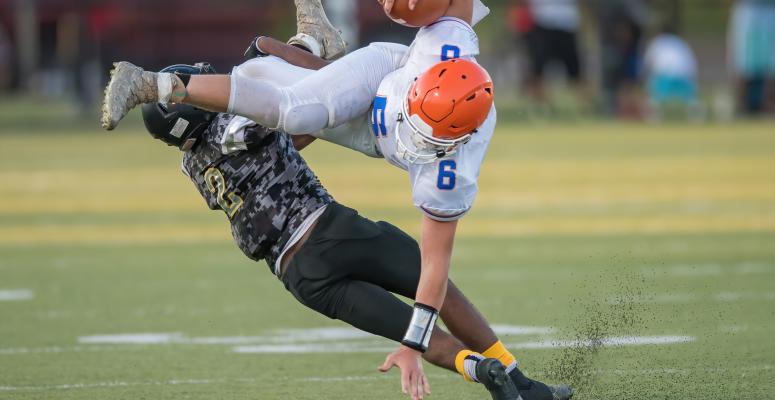
From top-performing athletes to -pickup basketball players, injuries happen. The goal of sports rehab physical therapy is to have each individual regain their active lifestyle and compete at their highest level possible. Sports injuries can mean time away from seasons, games or even careers. More than 8.6 million sports and recreation injuries happen each year in the U.S. Sports-related injuries account for nearly one-third of emergency room visits for adults aged 25 to 64 years old.
What is sports rehab physical therapy?
Sports rehab physical therapy is a specialized type of physical therapy focused on treating sports injuries. A sports physical therapist helps in the rehabilitation of their patients to get them back to their top physical function and sports-specific ability, no matter the current condition of the patient. It can help prevent simple sports injuries from developing into more serious conditions.
What are common sports injuries seen in sports rehab physical therapy?
Many sports injuries are minor and don’t require attention, and there are major sports injuries that are very serious and require immediate medical attention. The majority of sports injuries can be prevented with proper protective equipment or safety steps taken. Common sports injuries can include:
- Concussion — A concussion is a serious traumatic brain injury. It can occur when you experience a bump, jolt, or blow to the head or body that causes rapid back-and-forth movement of the head and brain. This movement causes the brain to bounce around in the skull, which causes chemical changes, stretching and damage of brain cells. This condition requires medical attention immediately. Concussions occur frequently in sports. The CDC estimates that up to 10% of athletes will experience a concussion. Athletes who experience a concussion should not return to activity without clearance from a trained health care professional.
- ACL tear — The anterior cruciate ligament (ACL) is one of the major ligaments of the knee. The ACL can be injured due to sudden stops, abrupt changes of direction, jumping or landing. This injury is common in sports such as soccer, football, basketball and skiing.
- Hip flexor strain — Hip flexor strains can occur due to the overuse of the muscle or due to injury caused by quick turns or sudden starts. This injury is common in running, hockey, soccer, martial arts and football.
- Shin splints — Shin splints refer to pain along the lower tibia (shinbone). They can happen in athletes who are runners or participate in sports that come with a great deal of running, such as soccer.
- Tennis or golfer’s elbow — Athletes performing a great deal of gripping are more likely to experience tennis or golfer’s elbow. It is due to overuse and repetitive motions, causing the tendons to become inflamed and making movement painful.
- Shoulder injuries — The shoulder is the weakest joint in the body and is vulnerable to forceful collisions during athletic activities. This can lead to dislocations, misalignments, strains and sprains.
- Patellofemoral syndrome — The majority of sports involve the lower body. A common knee injury is patellofemoral syndrome. This is caused by the patella (kneecap) moving improperly and experiencing swelling in the knee joint.
The most common injuries are minor in nature (bruising or sprains). The most severe injuries are concussions, dislocations and broken bones. No matter the sports injury, sports rehab physical therapy can be beneficial to recovery.
How sports rehab physical therapy can help your sports injury
Sports rehab physical therapy can help you recover from your injury and can also help prevent another injury from developing. Sports rehab physical therapy can be broken down into three specific phases such as:
- Phase one — The most important phase after an injury is the first phase. This phase is centered around the reduction of pain, inflammation, and swelling that is a result of the injury. The use of soft tissue mobilization and cold therapy may be beneficial here. Other manual techniques such as gentle stretching or joint mobilization may also be used to help focus on restoring and improving your range of motion.
- Phase two — The next phase of sports rehab is focused on building strength and improving your balance. Your therapist will take your specific injury and design a custom treatment plan around it. They will teach you how to progressively increase the load of the affected area with strength-training exercises. They can also add in custom exercises to provide additional support. This phase can be the starting point for those looking to improve their athletic performance and not treating a sports injury.
- Phase three — The final phase of sports rehab will include the introduction of sport-specific drills and exercises. This is where sports rehab differs from traditional physical therapy. During this phase, your therapist will pay close attention to your mechanics as you replicate movements needed for your particular sport and show you where you can improve your overall performance and endurance. As you continue to improve, they can create a return-to-sport timeline for you based on your progress. At the end of your PT, you will typically be cleared to return to your desired activities.
Techniques commonly used in sports rehab physical therapy can include:
- Soft tissue mobilization.
- Joint mobilization.
- Sports exercise.
- Electrical stimulation.
- Therapeutic ultrasound.
- Iontophoresis.
- Heat and cold therapy.
Find effective and affordable care for sports rehab physical therapy from an Alliance PTP partner
Physical therapy can be an effective and affordable way to care for your sports injury. You just need the right partner to provide it.
Alliance Physical Therapy Partners has you covered. We can help you find a PT clinic near you that’s staffed with experienced and caring physical therapists.
Prefer to meet with a physical therapist virtually? We’ve got you covered there, too.
Reach out to us today so we can help you find the physical therapy that works best for your needs.
Get Help at a Location Near You
